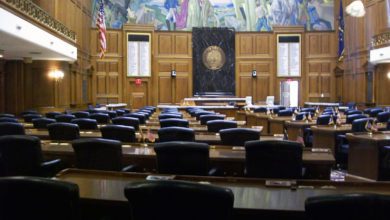
11 Ways the EPA Has Helped Americans
The budget proposal Donald Trump’s administration announced yesterday will slash the Environmental Protection Agency’s funding by nearly a third, crippling an agency that has played a key — but often unnoticed — role in American life for almost a half-century.
The main target of the president’s ire appears to be the agency’s climate change programs. “We’re not spending money on that anymore. We consider that a waste of your money,” Office of Management and Budget Director Mick Mulvaney said at a press conference. But cuts so large won’t just affect climate change-related programs — they will trickle down, affecting all of the agency’s work and the state environmental protection offices it supports.
Even Scott Pruitt, Trump’s climate science-denying EPA administrator, seems to feel Trump’s cuts go too far. When an initial budget proposal surfaced, slashing the EPA’s funding from $8.2 billion to $6 billion, Pruitt expressed concern about the effect a reduced budget would have on programs aimed at cleaning up and repurposing toxic and polluted sites, a function of the agency that he supports. The New York Times’s Glenn Thrush and Coral Davenport report that Pruitt lobbied Trump to rethink the cuts, but his appeal didn’t work: Trump’s finalized budget flouts his EPA administrator’s wishes by calling for even deeper cuts than initially proposed, slashing the agency’s budget to about $5.7 billion.
That budget isn’t final. It will still have to get through a Congress where even Republicans who have staunchly opposed the agency in the past are worried about what the funding cuts will mean for their districts. So, given that some in Congress might be deciding if and when to take a stand, we thought it would be a good time to take a look back at some of what the EPA has accomplished over the last 46 years, since Richard Nixon signed an executive order in 1970 bringing the agency into existence. These successes were, almost unanimously, won despite the strenuous and well-financed objections of recalcitrant polluters and are now almost unanimously taken for granted.
1. Patching the Ozone Hole
Remember the ozone hole? We don’t really, either. But ozone concerns were front-and-center in the ‘80s when, frighteningly, scientists discovered that pollution was causing the part of the upper atmosphere that protects us from the sun’s ultraviolet radiation to deteriorate. The issue came to a head when, in 1985, British scientists announced that an expanding hole had formed in the ozone layer over Antarctica.
The president at the time was Ronald Reagan, a zealous proponent of deregulation who did not seem to have strong feelings about environmental protection. But he surprised his advisers by vigorously backing the Montreal Protocol, an international treaty between 197 nations that banned chlorofluorocarbons, a chemical used as a refrigerant and found in aerosol sprays, and was to blame for the hole. (Why did Reagan take up the cause? No one is quite sure. One theory is that Reagan’s own experience with skin cancer made him particularly sensitive to the topic.)
Once the Montreal Protocol was signed, Congress amended the Clean Air Act to give the EPA the power to enforce a ban on chlorofluorocarbons and protect the ozone layer. The agency’s success in doing so, along with the efforts of environmental regulators worldwide, helped the hole begin to repair itself—and, it turns out, also lessened climate change. Though scientists didn’t realize it at the time, chlorofluorocarbons contribute to global warming. Climate change’s effects might be twice as bad if not for the Montreal Protocol.
2. Cleaning up America’s Harbors
When the EPA was created in 1970, the water around America’s cities was notably different than it is today. Cleveland’s Cuyahoga River was, famously, so thick with combustible industrial chemicals that it often caught fire. Manhattan was dumping some 150 million gallons of raw sewage into the Hudson River daily. Around the same time, a failing wastewater treatment plant in Boston was also spitting out vast amounts of sludge, leading health officials to warn that anyone who fell into Boston’s Charles River or the harbor it emptied into should go immediately to the hospital to be assessed by a doctor.
The EPA was responsible for dealing with these problems. The Clean Water Act of 1972 charged the agency with cleaning up America’s waters and provided billions of dollars to do so. Among other responsibilities, the EPA was tasked with laying down minimum standards for wastewater treatment before cities could release it. The EPA was also responsible for regulating city sewer systems so they wouldn’t overflow and spill sewage into the streets during heavy rains.
This made a big difference in America’s cities. New York brought a large, new sewage treatment plant online in 1986, solving Manhattan’s dumping problem. In Boston, a series of lawsuits prompted federal action. “Secondary treatment of sewage is a national standard, which means no more Boston Harbors,” said Union of Concerned Scientists President Ken Kimmell, who, as a former commissioner of Massachusetts’s Department of Environmental Protection, worked hand-in-hand with the EPA to clean up the water around the city. Boston Harbor is now one of the cleanest in the country.
3. Cracking Down on Lead
Industrial players who used lead fought regulation for years, with disastrous consequences for Americans. A 1985 EPA study estimated that as many as 5,000 people died each year from lead-related heart disease. Tackling lead poisoning was one of the agency’s founding agenda items, and it did so over strenuous objections from the industries that put it in their products. The metal is now virtually illegal, dramatically improving public health.
Legislation in the 1970s effectively banned lead from paint, and a 1985 EPA order required that the amount of lead in gasoline be cut by 90 percent by the following year. Five years later, a 1990 amendment to the Clean Air Act demanded that lead be removed entirely from gasoline by 1995. The EPA also reduced the amount of lead that could be emitted by smelters, mines, and other industrial operations, leading to an 85 percent decrease in the amount of airborne lead pollution between 1990 and 2015.
The effort, of course, was imperfect. A December 2016 Reuters report following Flint, Michigan’s lead crisis, found 1,100 areas around the country where lead levels were regularly four times what they were at the peak of Flint’s contamination. Many, like Flint, were in poor regions neglected by state and federal policymakers. Unlike other toxic chemicals, lead does not break down over time. But the agency’s efforts did have a significant impact. A 2002 study found that the level of lead in young children’s blood fell by more than 80 percent from 1976 to 1999, and that IQs increased as a result.
4. Making the Air Safe to Breathe
The agency also cracked down on other forms of air pollution, leading to a decrease in particulate matter and chemicals in the air that cause asthma. Their efforts meant a visible decrease in the smog that often choked cities in the ‘70s and ‘80s.
To do this, the agency cracked down on vehicle emissions and pollutants emitted by factory and power plant smokestacks. As the number of miles Americans travel per year has steadily climbed, and the amount of power Americans consume has grown, emissions have fallen.
That saved hundreds of thousands of lives each year and prevented millions fewer cases of asthma and other respiratory diseases. According to a peer-reviewed EPA study, these regulations, in particular, meant 165,000 fewer deaths per year in 2010 than in 1990 and 1.7 million fewer cases of asthma. One recent study found that thanks to these air pollution controls, children in Southern California have 10 percent larger and stronger lungs than children’s lungs 20 years ago.
5. Cleaning Up Industrialism’s Legacy
Throughout the 1960s and ‘70s, residents of Love Canal, New York, noticed an odd smell from the 99th Street School. And they saw that strange things were happening: Children’s sneakers melted to the pavement; dogs burned their noses when they sniffed them. The school was built on top of a toxic waste dump. The “canal” for which the town is named was filled with toxic waste by the Hooker Chemical Company for three decades — 22,000 tons in all — before, in 1955, the area was paved over, and a school was built on top of it. The chemical company had sold the property to the city for $1 — part of the deal, the “Hooker clause,” was that the company would not be liable if anyone got sick or died in the school.
When residents of Love Canal uncovered this sordid history, it provoked national outrage. Efforts to regulate toxic chemicals have already been underway. In 1976, Congress passed the Resource Conservation and Recovery Act to respond to concerns about illegal, toxic dumping and the Toxic Substances Control Act, which gave the EPA the authority to protect public health by regulating toxic chemicals. But in 1980, mainly in response to Love Canal and other toxic disasters that garnered headlines, Congress established a program to use a “superfund” to clean up America’s most poisonous places. Throughout the ’80s, the EPA put the money to work, cleaning up heavily polluted sites from landfills to oil spills, factory fires, and sludge pits throughout the US. A program for less urgent but still important cases, the Brownfields Program, was launched in 1995. It was tasked with cleaning up sites where contamination was an impediment to putting a vacant property to use better.
These programs, taken together, amounted to a formalized, government-supported environmental justice initiative, improving toxic sites that were unjustly distributed across America’s poor and minority neighborhoods. But, in recent years, shrinking appropriations from Congress have slowed cleanup efforts.
6. Making Water Safe to Drink
In 1974, Congress passed the Safe Drinking Water Act, allowing the EPA to regulate the water that came out of Americans’ taps. The agency ended up banning more than 90 contaminants from the water supply and cracking down on companies whose business practices poisoned Americans.
The EPA also issues “revolving funds” to communities to improve the infrastructure that brings water to homes and to water supplies.
7. Controlling Pesticides
The EPA has also regulated pesticides, which helps keep our food safe. The Federal Insecticide, Fungicide, and Rodenticide Act, a law dating back to the Progressive Era, was put under the EPA’s responsibility in 1972.
One of the agency’s first acts was to ban DDT, a pesticide introduced in the 1940s that poisoned wildlife, humans, and insects. The chemical’s effects were famously documented in Rachel Carson’s 1962 New Yorker serial Silent Spring, but the chemical industry, led by Monsanto, fought bitterly to keep it in use. The EPA’s decision to ban it was a major environmental victory.
8. Attacking Acid Rain
We heard much about acid rain in the ’90s, but don’t so much anymore. Congress took up the issue in 1990 — George H.W. Bush had campaigned on addressing it. Despite opposition from electric utilities, Congress passed an amendment to the Clean Air Act so that the EPA could regulate the chemicals to blame: sulfur dioxide and nitrogen oxides.
It worked. “Despite the doomsday warnings from some in the power industry that the regulations would cause electricity prices to spike and lead to blackouts, over the last 25 years, acid rain levels are down 60 percent, while electricity prices have stayed stable, and the lights have stayed on,” former EPA Administrator Gina McCarthy wrote in 2015.
9. Paving the Way for Indoor Smoking Bans
Back in 1993, the EPA, in response to overwhelming research, classified secondhand smoke as a pollutant likely to cause cancer. At the time, this position was braver than it might seem today. Tobacco companies had waged a multidecade-long campaign to keep Americans smoking by questioning the link between cigarettes and cancer, even going so far as to suppress their own internal research that indicated otherwise.
The following year, tobacco CEOs admitted in testimony before Congress that cigarettes were dangerous. However, their lobbying efforts against regulation would continue for years (a PR effort spearheaded by, among others, Myron Ebell, who resurfaced on Trump’s EPA transition team). But the EPA’s decision prompted a wave of city- and statewide indoor smoking bans; the majority of states now have them in place. And in the decade and a half following the EPA classification, the number of Americans who smoke — and, in particular, the number of high school-aged Americans who smoke — decreased dramatically.
10. Building a Cache of Public Data
One of the EPA’s most significant resources is the vast supply of information it has collected over four decades, some of which is available to the public through the Internet. This data provides excellent documentation of the threat posed by climate change, but it isn’t limited to that. Spread across dozens of databases, the numbers include information such as the chemical compositions of various toxic pollutants and the locations in the US that those pollutants affect. The databases document the trends in air and water pollution, acid rain, and the health of beaches and watersheds. It tracks which companies have been inspected and cited for enforcement.
Scientists are worried about the fate of this data under Trump and have been scrambling to preserve it. “There is no reason to think the data is safe,” Gretchen Goldman, a research director at the Union of Concerned Scientists, recently told The Guardian. “The administration, so far, hasn’t indicated it will respect science and scientific data, especially when it’s inconvenient to its policy agendas.”
11. EPA Addressing Climate Change
The US government’s effort to address the most significant climate threat to face the modern world will — at least for the time being — be cut short. However, during Barack Obama’s second term, the EPA began to figure out what serious US efforts to address climate change would look like. In the face of an intransigent Congress, Obama ordered the agency to take the lead, and under Administrator Gina McCarthy it did, drawing up plans to, among other things, raise the number of miles per gallon gas vehicles were required to achieve and to cut pollution from US power plants.
The Trump administration will toss out both of those initiatives. While they were on the books, they were enough of an indication of America’s commitment to dealing with the climate crisis that other large polluting nations—notably China—came to the negotiating table in good faith. That led to the Paris Agreement, a pact that the US looks likely to either withdraw from or ignore, but that the world appears set to continue upholding without us.






